Highway 16 running through parts of north-central Alberta and into mainland British Columbia has a second, more ominous name that’s recognizable to most — the Highway of Tears. This stretch of highway was given this name because of the number of Indigenous Women, Girls, 2-Spirit People, and countless others rooted in Indigenous Nations who were either murdered and found along this highway or went missing while along this highway.
There have been initiatives like the National Inquiry into Missing and Murdered Indigenous Women and Girls (MMIWG) that have made great strides to address this issue and educate the public. But, in 2011 a young woman and her father launched their own awareness campaign from people who have their own roots with Indigenous Nations.
Addressing MMIWG from a lived-Indigenous experience
Raven Lacerte and her father Paul started the Moose Hide Campaign and included one distinct symbol as a commitment to ending gender-based and Indigenous targeted violence — wearing a pinned square of moose hide.
To this day, the Moose Hide Campaign organization distributes these pins along with information cards as a gift of medicine. Adding to the Indigenous lens, the website suggests a $1 donation when ordering gifts of medicine as a gift of reciprocity and helping to ensure the Moose Hide Campaign remains sustainable.
Moose Hide Campaign’s main awareness event is its walk in Victoria, British Columbia, on May 15 — but this is far from the only Moose Hide Campaign event. Dozens of individual walks are happening across the country, including one in Edmonton at City Hall.
In addition to the walks, it’s also encouraged to fast as part of this awareness campaign. In many Indigenous Nations and communities, fasting is seen as a symbol of your commitment and a way to deepen your intention towards this commitment. It’s encouraged, but not required, to fast from sunrise to sunset to further solidify your resolve.
Moose Hide Campaign events and how you can get involved
This is a very-high level overview of this immensely impactful movement. The wisdom and knowledge shared by the Lacerte family and the rest of the Moose Hide Campaign team illuminates many of the issues faced by women, girls, 2-Spirit Peoples, and other Indigenous Peoples while firmly rooted in Indigenous culture and community — an important perspective for us all to listen to and gain a better understanding from.
Discover more about the Moose Hide Campaign and how you can showcase your commitment to ending gender-based and Indigenous Peoples targeted violence at Edmonton City Hall.
The 2020s has been an important decade for Canada’s relationship with the Indigenous Nations. We’re seeing large institutions like Canada’s federal government acknowledge and recognize the atrocities committed against Indigenous Peoples.
One incredibly important stride forward was the publishing of the Final Report from the National Inquiry into Missing and Murdered Indigenous Women and Girls (MMIWG). This more than 700-page report highlights interviews with more than 2,300 people affected by violence against Indigenous People.
These stories illustrate the challenges faced by women and girls, and the continued violence against members of the 2SLGBTQIA+ community. By reading this document, we can gain better knowledge on the marginalization experienced by Indigenous Peoples — and ultimately, have the wisdom and perspective to know what we can each do individually to help create a more equitable world.
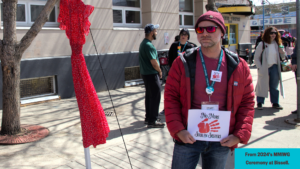
The Four Key Areas of Rights for Indigenous Peoples
In addition to the 231 recommendations the report makes to help end violence and marginalization against Indigenous Peoples, it highlights four key areas of rights for Indigenous Peoples and provides explanations as to how each help work towards this goal of ending violence:
- Right to Culture – this right specifically highlights previous generations trying to assimilate Indigenous Cultures and Nations and how these efforts created the foundation for the marginalization Indigenous Peoples continue to experience today.
- Right to Health – this highlights how all people within Canada have the right to access health care. For countless people rooted in Indigenous Nations, this is an area where they have experienced discrimination — this barrier to health care further adds to the violence experienced by Indigenous Peoples.
- Right to Security – countless stories shared through this national inquiry demonstrated the near constant threat Indigenous Peoples face while living day-to-day. And it’s not only physical security: emotional, mental, social, and cultural security are all key to ending this disproportionate violence.
- Right to Justice – experiences through Canada’s justice system can be incredibly inconsistent for Indigenous Peoples. These disconnections through Canada’s justice system can further perpetuate the violent experiences of Indigenous Peoples.
Why Education is Foundational to Ending Violence
While the 231 recommendations and the four key areas of rights largely focus on larger-scale systemic changes, that doesn’t mean everyday people are powerless to help steer this change along.
In fact, just being more aware of the kind of violence that Indigenous Peoples are facing is the perfect foundation needed to see the kind of change that will help end this violence.
Any meaningful action starts with awareness and education. With the knowledge and wisdom of the issues, their roots causes, and what needs to be done to address this inequity, the better you can direct your own actions to be more equitable to people rooted in Indigenous Nations.
And the more people there are who fully understand the issues and how to direct their own actions, the more forward momentum we can see to finally seeing an end to this disproportionate violence.
The fire crackles in front of 14 Elders and Knowledge Keepers sitting in a circle sharing, reflecting, and trying to imagine a more positive future for their communities. They were all invited to Moonlight Bay Centre for a retreat to commemorate National Day for Truth and Reconciliation — a day that can be especially difficult for these Leaders in their communities.
Many of them have either witnessed firsthand the atrocities of residential schools or have close family members who have shared their own stories (if they came home at all). And while the Elders and Knowledge Keepers reflected on the past and the challenges of the present, a new feeling emerged, seemingly from the embers and ashes dancing off the campfire.
They felt hope for the future.

Thoughtful Reflections Sitting by the Water
While this retreat included much of what someone might expect to find at an all-inclusive resort, the true aim for this event was to pay homage to the hard work of Elders and Knowledge Keepers acting as near-constant beacons of hope, helping their communities to safer waters. And while grief and reflection were ever-present, so was friendship, comradery, love, and optimism that they will continue navigating troubled waters.
“Many of the Elders and Knowledge Keepers who attended told me they had no idea we had a property so close to the water like this,” says Janet Paskemin, Manager of Indigenous Cultural Supports. Moonlight Bay Centre sits on Wabamun Lake with wonderful views of the water and surrounding woods.
“Just being by the water can do a lot for Elders and Knowledge Keepers,” says Janet. “It can help them clear their minds, reflect more thoughtfully, and think much clearer. For a lot of this retreat, the Elders and Knowledge Keepers sat by the lake, sometimes talking but more often just in silence with each other.”

Comradery, Friendships, and the Gifts of Food
While some of the Elders and Knowledge Keepers who attended were longtime friends, just as many had never met — despite this, the comradery was more than evident. These bonds formed sitting by the lake, solidified by the fire, but it was in the kitchen where one of the strongest gestures took shape.
Food Sovereignty is an act where visitors to Indigenous Nations would receive food as a token of gratitude and friendship. True to honouring the customs and traditions from Indigenous Nations, one Elder, who was previously a Chef, insisted on making home-made pancakes for everyone at the retreat.
“In truth, he wanted to give something to his friends, the same way we were giving so much to everyone during that retreat,” says Janet. “It’s hard to understate how important gestures of honour, friendship, and love are for the Elders and Knowledge Keepers.”

Hope for the Next Generations
Janet recalls one thing she heard time and time again throughout the retreat: that the Elders and Knowledge Keepers see the work that’s being done for Indigenous Peoples by so many young people. She expressed how the Elders and Knowledge Keepers are so incredibly hopeful for the next generations to continue improving the lives of others.
We were honoured to host the 14 Elders and Knowledge Keepers at Moonlight Bay Centre to acknowledge National Day for Truth and Reconciliation. We’re proud knowing that these important leaders in their communities had an opportunity to not only rest and reflect but to connect, share, express, and revitalize.

Around 50 per cent of pregnancies in Canada are unintended. This could mean a person might not be looking for any of the signs and could only find out later in the term that they’re expecting. Without knowing, a person will likely continue with their lifestyle — including medical and recreational substances.
More than a decade ago, the Red Shoe Walk kicked off to start discussions about Fetal Alcohol Spectrum Disorder (FASD) – a condition that affects upwards of four per cent (4%) of Albertans. This is a condition where a fetus is exposed to alcohol and delays development physically and mentally — which can affect a person for the rest of their lives. FASD is widely misunderstood as a condition, but it’s not only the people living with it who face misconceptions — the worst treatment is often reserved for their mothers.

Cryptic pregnancies and missing hormones
The real reasons why someone might drink while pregnant are always much more nuanced. While there is a knee jerk reaction to assume malice or gross irresponsibility, there is a very real likelihood that they never knew they were pregnant at all.
Approximately one in 2,500 women experience what’s called a cryptic pregnancy. This means everything typically associated with the experience of being pregnant (morning sickness, weight gain, pains, etc.) are not present at all for the duration of their pregnancy — often only learning that they’re pregnant once they’ve delivered their new child.
This can happen for a myriad of reasons. One common reason occurs in approximately one in 475 pregnancies where the body doesn’t produce the HCG hormone that tells the body it’s pregnant. And while there are biological reasons why someone may not know they’re pregnant and might ingest alcohol while pregnant, the social conditions can play a much larger role.

Misinformation and social pressure
Misinformation concerning alcohol and pregnancy is rampant. From alcohol helping pregnant people to sleep, to red wine being a healthier choice, it can be easy for people to rationalize drinking alcohol while pregnant — after all, western culture does have a strong emphasis on normalizing alcohol.
When bad information reaches vulnerable populations, it can lead to disastrous decisions. Some individuals experiencing poverty (around 10 per cent of women in Canada live on low incomes) are susceptible to misinformation like anyone else. With added stresses like housing insecurity (which affects 28 per cent of women), bad information can begin to pass through one’s better judgement filters. Issues around online media literacy is rampant across our society today and this is only one more area where inaccurate content can do incredible harm.
Adding to the issue is access to sound medical advice from reputable sources. Many vulnerable people might not have access to a medical professional for advice — whether that’s because of location or even trust in medical establishment. Depending if a person carries trauma around medical institutions (as many vulnerable people do), they could distrust medical experts and instead lean on advice from social platforms.
While organizations like us, as well as drink manufacturers and establishments are all working to better inform people on the harms of drinking alcohol while pregnant, the social pressures to drink alcohol and potentially misinformed outside influence could lead a person to thinking they are making a fully-informed decision.

Supporting those affected by FASD
This is where shaming individuals who drank while pregnant can do even more harm. The frequently cited four per cent of the population is likely an underestimate — because people avoid talking about something that leaves them feeling ashamed. This could even prevent people from seeking out any further supports that could help with their and their child’s quality of life.
What’s most important is ensuring anyone affected by FASD has the supports they need. This is why Bissell has its Fetal Alcohol Spectrum of Services (FASS), working with the Edmonton and Area Fetal Alcohol Network (EFAN) program providing supports for individuals and families alike with referrals for FASD diagnoses and system navigation to help people find the best services and supports for their individual needs. We also run Hope Terrace — a first-of-its-kind permanent supportive housing complex specifically designed for people with FASD. With wraparound supports in place, the folks who call Hope Terrace home can learn to lean on their strengths to give back to their larger communities.
While the Red Shoe Walk started to spark conversations about FASD, it’s worth talking about everyone affected by the condition. This includes those who live with FASD and their mothers who may have an experience worth sharing and learning from. Reducing stigma around all dimensions of FASD will help lead us to a better quality of life for those affected by FASD, and better tools to help prevent any future risks of FASD.

June is an important month for Bissell Centre – it’s both Pride Month and National Indigenous History Month. There is a close connection between what Pride Month is all about and Indigenous history in our country.
Countless Indigenous Nations across what’s now called North America saw Two-Spirit Peoples as not only an engrained and normalized part of their culture — Two-Spirit Peoples were often highly regarded and seen as a gift from the Creator.
“They were a very important part of Cree society,” says Elder Ed Lavallee. He is a traditional Plains Nehiyaw (Cree) of the Sturgeon Lake First Nation in Saskatchewan whose career in advocacy for Two-Spirit Peoples has seen him collaborate with groups like Pride Edmonton, the Edmonton Queer History Project, and the Edmonton 2 Spirit Society. Quotes from Elder Ed Lavallee reflect the distinct experience of the Plains Nehiyah Peoples.
“They had many roles in the daily lives of their people and were respected and revered for being Two-Spirited. They were often healers, shamans, mediators in marriage and tribal disputes, keepers of their history and their lore, and taking part and often leading in their social and Spiritual Ceremonies.”
While colonial efforts tried to wipe out any non-conformity from a person’s ascribed gender, the presence of these folks never went away. It wasn’t until 1990 that this way of being was finally given a general English translation to help people across Canada understand that, for countless Indigenous Peoples today, there are far more than only two genders.

The Five Genders
For Indigenous Nations in what’s now called Alberta, there are five genders in the community: male, female, male with female spirit, female with male spirit, and transgender.
“Indigenous people believe that both the female and male spirits reside in the body of a Two-Spirit Individual and the degree of dominance of each spirit ultimately impacts the physical, emotional, mental and spiritual identity of each Two-Spirit person,” says Elder Ed Lavallee.
Rather than trying to change people to better fit with the gender they were born with, Indigenous Nations instead made room for these people and ensured they could contribute to the community with the tasks and skills they identified with most.
Males with female spirits could take on cooking and cleaning duties, were widely seen as gifted artists, and some Nations even saw them adopt orphaned children to take on a caregiver role. Females with male spirits contributed by hunting and being warriors. Some Nations saw females with male spirit folks marrying widowed women.

The Reverence for Two Spirit Peoples
In addition to the everyday contributions Two-Spirit Peoples made to their communities, their gift of having two spirits within them also meant they were good healers, medicine people, and visionaries. This is because the two spirits in them give them what’s called double-vision — the ability to see the world through both the male and female lens.
“The belief that Cree Two-Spirit People are special is epitomized in the existence of a powerful Two-Spirit Deity known as Qweskicanskew,” adds Elder Ed Lavallee. “In their spirituality, they believe this Spirit turns things around for the good and well-being of all things on earth. This important Spirit is called upon in prayers for help, protection and blessings.”
Two-Spirit Peoples were foundational to their communities. During colonization, Two-Spirit Peoples’ place in the world seemed to no longer exist. Through the mid- to late-twentieth century, as more Indigenous Peoples began to reclaim their identities, it was clear the different terms used in different Nations like Nádleehí (nad-lay-hee), Winkté (wink-tay), and Niso-acahk-iynew (nee-soh-achak-ee-noo) needed a translation for the wider public to understand.
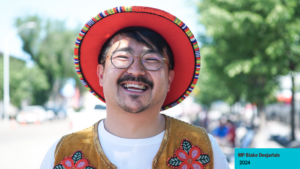
Bringing Two Spirit to the Wider Public
In 1990, at the Third Annual Intertribal Native American, First Nations, Gay and Lesbian American Conference, Elder Myra Laramee put forth the term Two-Spirit. The term is a translation from the Anishnaabemowin (Ojibwe language) term Niizh Manidoowag (neez man-ee-doo-wog). It was added to the front of the Pride acronym (2SLGBTQIA+) in recent years and was even a part of the focus for the Federal 2SLGBTQIA+ Action Plan launched in 2022.
Today, knowledge and understanding about Two-Spirit Peoples is spreading, but is still far behind from where it was before colonization. People like Dr. James Makokis (a Two-Spirit doctor from Kehewin Cree Nation) and MP Blake Desjarlais (a Member of Parliament from Edmonton) are sharing their stories to help more people understand why Two-Spirit Peoples are an essential part of their Nations – and to reduce the stigmatization around people living their authentic lives.
“They are emerging from their long decades of oppression and marginalization working toward re-establishing their rightful roles in their communities as they go through this period of rediscovery,” says Elder Ed Lavalle. “They are working to be recognized, respected and engaged in an integral manner, within Indigenous communities and society in general.”
This Pride Month and National Indigenous History Month, we’re celebrating the bravery of Two-Spirit people coming out and bringing this piece of Indigenous culture to the public forefront. We hope you’ll join us in making room for Peoples who can walk in both worlds to share their gifts and help make this world a more equitable place for everyone.
The role family plays in many Indigenous cultures can’t be understated. Blood familial ties and chosen families can hold the most sacredness and honour for Peoples in Indigenous Nations. The Community at Bissell Centre is no different.
Those strong family ties are especially prevalent at our National Indigenous Peoples’ Day (NIPD) event outside our Community Space (10530 96 Street) every June 21. This is a day of celebration where we block off part of the street, invite performers and artists to share their crafts, and serve some of the best Indigenous cuisine you can find in the city.
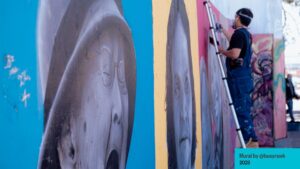
The Reverence held for Elders
Honouring Elders is one of the most important customs of NIPD. The knowledge and teachings these individuals hold in the communities not only preserves the traditional ceremonies and rituals that bring so much vibrancy and life to Indigenous Nations – they can also help guide individuals through challenges and onto the most life-affirming paths.
“One of the most important services we can offer with Bissell’s Indigenous Engagement Program is connecting individuals to Elders,” explains Sarah Higgins, Director of Indigenous Engagement and Integrated Family Services – and a Red River Métis woman. “The teachings and guidance Elders can provide and the connection they foster to Indigenous Nations can help a person decide it’s time to reach out for further supports in their unique journey out of poverty.”
At the NIPD event, you’ll see a tent specifically for Elders to sit in. They’re often accompanied by children from Indigenous Nations, as well, symbolizing how their knowledge will be passed down through generations to ensure the culture and traditions remain a vital part to one’s Indigenous identity.
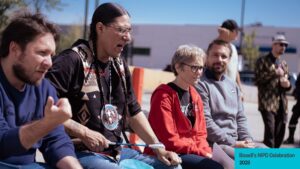
The Crucial Chosen Families Built in the Community
For people accessing the services at Bissell Centre, families by blood aren’t always a part of their lives, yet the importance of family never really goes away for a lot of folks. Creating new chosen families then becomes a part of life in the community.
“It’s not uncommon to see folks in the community calling each other uncle, aunty, or cousin because this is the family they’ve built for themselves,” says Higgins. “Just like a family, these are support systems for each other and we see these connections as real family – just the same as any blood tie.”
Families and communities coming together to celebrate the resiliency of Indigenous Peoples shows how important NIPD is for the folks in downtown Edmonton. And no matter what that family looks like and who makes up that unique family unit, NIPD will have space for all who attend to celebrate the strength, culture, and customs from Indigenous Nations.
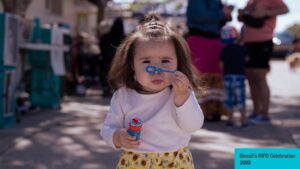
We can’t say enough about our Community Space. This is the central hub where folks can come by for a hot meal, hot shower, fresh clothes, and to build relationships with people to grow their support network.
This space is invaluable to the folks who access its services every day. And, this is why our biggest fundraiser of the year, our Coldest Night of the Year walkathon, sees money raised going directly back into the operations and programs in the Community Space. For a lot of folks, this space is so much more than a warm, indoor place to meet daily necessities – it can also be the first step towards finding their unique pathways out of poverty.

Relationships are everything in the Community Space.
While things like meals and showers might be what first brings people through the doors, they soon learn what other programs might help them along. We offer programs like housing, employment, and mental health, to name a few, which help uncover what barriers people are facing. As staff work to build relationships with people to help find their strengths, folks can start recognizing how best to address these root causes.
No two experiences with houselessness are alike. Building positive relationships can help people recognize their strengths and resiliency – ultimately helping them find their path out of poverty. And, when they’re ready to take those first steps in their journey, Bissell Centre staff help find the resources they need to live a good quality of life.
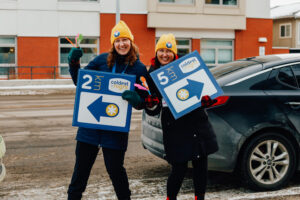
Every journey is unique – and everyone gives back differently.
Doug has been coming to the Community Space for a few years now. In his own words, it’s his home away from home. The relationships he’s built are like family to him. And like any good family, he finds ways to give back.
The main way Doug gives back to the Community Space is by volunteering in the Community Closet, helping folks find new clothes. Other times, Doug walks around the encampments nearby to see if anyone needs any help. Any way that Doug can help, he wants to offer it to the community that’s given him so much.
“If it weren’t for Bissell Centre, I think we’d all be lost,” says Doug. “They’re helping me out, so I want to help them out too.”

How you can help too.
This year’s Coldest Night of the Year fundraising walk sees all proceeds raised going directly back to the Community Space to support its invaluable operations and programs. Start a team, raise some money, and bring out the whole family for a walk downtown on February 24, 2024. Thank you to all our event sponsors, including our Lead Sponsor Capital Power for providing the single largest sponsorship contribution we have ever received.
If you ask Myles Richter if he has a secret weapon for recruiting in manufacturing for his frontline and entry-level positions with Lux Architectural Products, he’ll immediately point to recruitment efforts from Workforce Development.
“For us this program has been a hidden gem that we have shared with multiple business contacts, who like us, were struggling to find reliable workers,” says Richter. “It is somewhat perplexing that there seems to be a bit of a labour shortage while capable people are in our own community that only require a second chance at work. It is hard for me to believe that more businesses do not see the benefit of hiring candidates from the Workforce Development program.”
Filling vacancies in manufacturing has been a challenge across the industry, and business owners are seemingly constantly considering new approaches to finding talented and hard-working individuals looking to make an impact with their work. For Richter, that solution has been Workforce Development.
Multiple Successful Hires
Over their first year working with Workforce Development, Richter was able to successfully add three members to his manufacturing team. He worked closely with the Workforce Development team to identify suitable candidates to fill their entry-level vacancies.
“Whenever we are in need of more help, I can email the team and they will send me some potential employees that are either close to or have recently graduated from the program,” says Richter. “It is a bonus for us that the team at Workforce Development knows what we are looking for as well as what kind of roles the candidates would be best suited for within our business.”
It’s not only the employer partners that the Workforce Development team gets to know so closely. The team gets to know each individual program participant on a deeper level to understand their employment and life goals – and how different employers can help them realize their goals. By knowing both the employers and potential employees so well, they can better match opportunities for better business results.
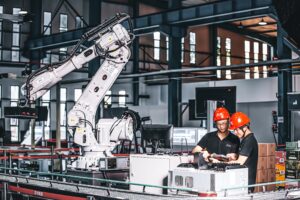
Ready to Make an Impact on your Business and the Community
Beyond the benefit to the business, Richter also recognizes the need to allow people to find work where they will flourish. Having the best of both worlds means he can hire a team of dependable and capable individuals – while also helping people looking to re-enter the workforce and make an impact on their community.
“As a business, we are able to hire capable, reliable people with real life experience and work ethic,” says Richter. “The program provides training courses relevant to their work here such as CPR and First Aid certification and forklift training at no charge to us. From a business perspective, we can hire quality people that are willing and ready to work – but from a personal perspective, we are able to hire decent humans that deserve a second chance in the work force.”
Our Workforce Development program is looking for new employer partners – including ones in the manufacturing, warehousing, and construction industries. Discover how partnering with Workforce Development could help you and your business thrive. Because everyone deserves work that allows them to shine.
Ever wonder what kind of impact your donated goods make on your community? Documentaries like Minimalism: Less is Now and The True Cost highlighted a few problematic practices from some organizations that rely on clothing donations. There can be an immense impact on the environment from discarded clothing and goods.
Bissell Centre takes a more social and environmentally ethical approach to donated goods. Environmental justice and social justice go hand-in-hand – those experiencing houselessness see the most adverse effects as a result of climate change. Just look at our community’s frost bite concerns over the winter and the heat warning over the summer.
Every donation we accept helps us work towards our mission of eliminating poverty in Edmonton. Goods we receive go one of three places: our Family Supports team, our Community Closet, and our two Thrift Shops.
Family Supports
This program sees support workers helping families navigate their way out of poverty. This can include help with childcare and early childhood development, finding permanent housing, and other essentials that help people live with dignity.
Donations to Family Supports provide families with fresh clothing plus home goods to help them settle into their new homes. Home goods can include small appliances, utensils, dishware, and even storage containers.
Community Closet
Nestled in our Community Space, the Community Closet is where individuals experiencing poverty can go for a fresh set of clothes. Many of our community members go weeks or months without changing their clothes. Bacteria can fester in clothing worn for too long, leading to easily preventable fatal infections and diseases.
We supply folks with everything they need to feel more comfortable and confident – pants, shirts, jackets, shoes, and even underwear! In addition, we also offer free laundry services to our community members to ensure that the clothes they have remain clean and comfortable.
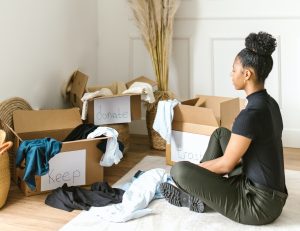
Bissell Thrift Shops
We have two locations for our Thrift Shops – Alberta Avenue (8818 118 Ave) in North Central Edmonton and Hermitage (12769 50 St.) in the North East. We also have an online store, an Etsy page, and an active Instagram account showcasing some of the coolest finds donated to Bissell Centre.
But it’s not only about treasure hunting and cool finds. A lot of people in these lower-income neighbourhoods rely on thrift shops for everything from clothes to bedding and even homewares. Plus, 89 cents from every dollar from the Thrift Shops goes back into our life-changing programs. This means you can thrift for a good cause – watch every dollar you give to the thrift store go right back into the community and to the people who need it most.
The new Indigenous Engagement program is a spark of connection, igniting a deep sense of belonging through the customs that define Indigenous identities. Together, we remember the past, learn from our ancestors’ wisdom, and embrace it all with open hearts. In this shared journey, we strengthen our bonds and foster understanding.
Guided by the Seven Sacred Teachings: Love, Respect, Courage, Honesty, Wisdom, Humility, and Truth, this program serves as a bridge to Indigenous heritage and a platform for nurturing improved relationships between Indigenous and non-Indigenous communities across Canada.
Launching for National Day for Truth and Reconciliation
“Listening attentively to the voices of our community, we have crafted programs that provide opportunities to connect with Indigenous roots,” says Sarah Higgins, Director of Indigenous Engagement at Bissell Centre. “We focus on celebrating age-old traditions while exploring new ways to honour them.”
The program has been active over 2023 but is officially launching at the end of September – consciously coinciding with National Day for Truth and Reconciliation. Higgins explains how launching this new Indigenous Engagement program at the same time as this important ceremony for Indigenous communities is part of a larger reclamation of Indigenous culture and an important part of the healing that the community needs.
Reclaiming Indigenous Cultural Practices
“We have a large overrepresentation of Indigenous people accessing Bissell Centre programs,” says Higgins. “This program is a direct response to what we were hearing directly from the community. Holding our ceremonies, performing our smudges and our songs, collecting our medicines, and accessing the wisdom of our elders – these are all foundational to what we’re providing in this program.”
She goes on to point out that the ceremonies and customs practiced in the Indigenous Engagement program would have been illegal up until 1951, when the Indian Act was first amended to end its discrimination against Indigenous traditions. Higgins is proud to lead a team that ensures the customs and rituals practiced by Indigenous peoples have a home at Bissell Centre – where they can reach a lot of people who need it most.
Discover more about how the new Indigenous Engagement program by Indigenous folks, for Indigenous folks, is helping more people honour and connect to their culture.




















